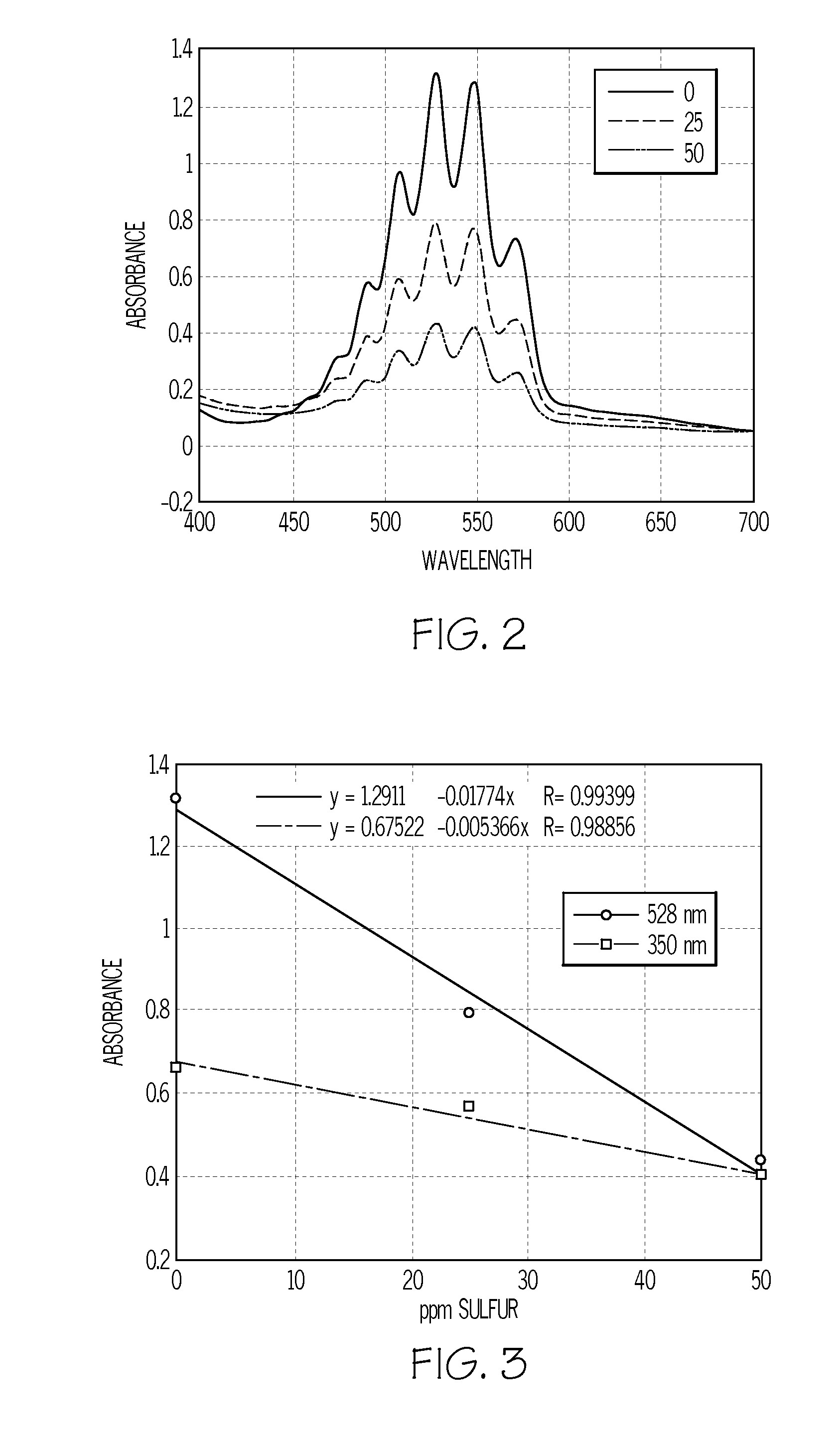Method of analyzing sulfur content in fuels
a sulfur content and fuel technology, applied in the field of methods of detecting sulfur compounds in fuels, can solve the problems that the current astm methods used for low sulfur determinations are not suitable for on-site, non-technical operation
- Summary
- Abstract
- Description
- Claims
- Application Information
AI Technical Summary
Problems solved by technology
Method used
Image
Examples
example 1
[0034]Various amounts of methyl phenyl sulfide were added to kerosene (0 ppm sulfur) to produce 0, 12, 25 and 50 ppm sulfur standards for developing a KMnO4 test for measuring the sulfur concentrations of ULSD fuels (expected to be 15 ppm and below). Two ULSD fuels containing 6 ppm sulfur and two non-ULSD fuels containing 400 ppm sulfur (sulfur concentrations determined by X-ray fluorescence: ASTM D-3120) were also obtained for KMnO4 test development.
[0035]To determine the best wavelength(s) to be used for the spectrophotometric trending of the KMnO4 depletion resulting from its reaction with natural antioxidants and sulfur compounds contained in ULSD and non-ULSD fuels, the initial tests were conducted in 5 mL glass vials. In each glass vial 0.025 mL of 0.5% KMnO4 in water, 3 mL of acetone containing 1% acetic acid and 0.25 mL of kerosene sulfur standard were dispensed (in that order). Each vial was then capped and hand shaken for 10 seconds (kerosene soluble in acetone). Color dif...
example 2
[0038]As a second test of the linearity of the absorbance vs. sulfur concentration relationship as well as the sensitivity of the test, the tests were repeated with 0, 12 and 25 ppm sulfur standards prepared in kerosene and dissolved in ethyl acetate (instead of acetone) containing 1% acetic acid. The tests were conducted using 5 mL glass vials with each vial containing 0.025 mL of 0.5% KMnO4 in water, 3 mL of ethyl acetate containing 1% acetic acid and 0.25 mL of kerosene sulfur standard. Each vial was capped and hand shaken for 10 seconds (kerosene soluble in ethyl acetate). Color differences were visually noted after 30 seconds: 0 ppm sulfur standard solution had no color change; the 12 and 25 ppm sulfur standard solutions had lightened in color. The prepared solutions were then poured into a square, quartz cuvette for UV-VIS spectrophotometric analysis. Instead of using the absorbance reading of the peak at 528 nm, the area under the absorbance curve from 450-600 nm (FIG. 2) for...
example 3
[0039]As a third test of the sensitivity of the absorbance test, the tests were repeated with 0 and 25 ppm sulfur standards prepared in kerosene and suspended in water (instead of acetone) containing 0.1% phosphoric acid. The tests were conducted using 5 mL glass vials with each vial containing 0.025 mL of 0.5% KMnO4 in water, 3 mL of distilled water containing 0.1% phosphoric acid and 0.25 mL of kerosene sulfur standard. Each vial was capped, hand shaken for 20 seconds (kerosene insoluble in water), allowed to sit for 20 seconds, then hand shaken for an additional 20 seconds. Color differences were visually noted after the additional 20 seconds of shaking: 0 ppm sulfur standard solution had no color change; the 25 ppm sulfur standard solutions had lightened in color, turning an orange-yellow color. The prepared solutions were allowed to sit for 2 minutes to allow the fuel to separate from the water layer. The clear water layer was then pipetted into a square quartz cuvette for UV-V...
PUM
| Property | Measurement | Unit |
|---|---|---|
| wavelengths | aaaaa | aaaaa |
| wavelengths | aaaaa | aaaaa |
| wavelengths | aaaaa | aaaaa |
Abstract
Description
Claims
Application Information
 Login to View More
Login to View More - R&D
- Intellectual Property
- Life Sciences
- Materials
- Tech Scout
- Unparalleled Data Quality
- Higher Quality Content
- 60% Fewer Hallucinations
Browse by: Latest US Patents, China's latest patents, Technical Efficacy Thesaurus, Application Domain, Technology Topic, Popular Technical Reports.
© 2025 PatSnap. All rights reserved.Legal|Privacy policy|Modern Slavery Act Transparency Statement|Sitemap|About US| Contact US: help@patsnap.com



